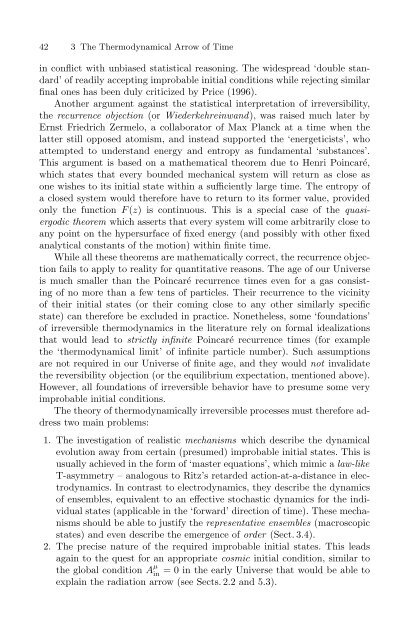The Physical Basis of The Direction of Time (The Frontiers ...
The Physical Basis of The Direction of Time (The Frontiers ...
The Physical Basis of The Direction of Time (The Frontiers ...
Create successful ePaper yourself
Turn your PDF publications into a flip-book with our unique Google optimized e-Paper software.
42 3 <strong>The</strong> <strong>The</strong>rmodynamical Arrow <strong>of</strong> <strong>Time</strong><br />
in conflict with unbiased statistical reasoning. <strong>The</strong> widespread ‘double standard’<br />
<strong>of</strong> readily accepting improbable initial conditions while rejecting similar<br />
final ones has been duly criticized by Price (1996).<br />
Another argument against the statistical interpretation <strong>of</strong> irreversibility,<br />
the recurrence objection (or Wiederkehreinwand), was raised much later by<br />
Ernst Friedrich Zermelo, a collaborator <strong>of</strong> Max Planck at a time when the<br />
latter still opposed atomism, and instead supported the ‘energeticists’, who<br />
attempted to understand energy and entropy as fundamental ‘substances’.<br />
This argument is based on a mathematical theorem due to Henri Poincaré,<br />
which states that every bounded mechanical system will return as close as<br />
one wishes to its initial state within a sufficiently large time. <strong>The</strong> entropy <strong>of</strong><br />
a closed system would therefore have to return to its former value, provided<br />
only the function F (z) is continuous. This is a special case <strong>of</strong> the quasiergodic<br />
theorem which asserts that every system will come arbitrarily close to<br />
any point on the hypersurface <strong>of</strong> fixed energy (and possibly with other fixed<br />
analytical constants <strong>of</strong> the motion) within finite time.<br />
While all these theorems are mathematically correct, the recurrence objection<br />
fails to apply to reality for quantitative reasons. <strong>The</strong> age <strong>of</strong> our Universe<br />
is much smaller than the Poincaré recurrence times even for a gas consisting<br />
<strong>of</strong> no more than a few tens <strong>of</strong> particles. <strong>The</strong>ir recurrence to the vicinity<br />
<strong>of</strong> their initial states (or their coming close to any other similarly specific<br />
state) can therefore be excluded in practice. Nonetheless, some ‘foundations’<br />
<strong>of</strong> irreversible thermodynamics in the literature rely on formal idealizations<br />
that would lead to strictly infinite Poincaré recurrence times (for example<br />
the ‘thermodynamical limit’ <strong>of</strong> infinite particle number). Such assumptions<br />
are not required in our Universe <strong>of</strong> finite age, and they would not invalidate<br />
the reversibility objection (or the equilibrium expectation, mentioned above).<br />
However, all foundations <strong>of</strong> irreversible behavior have to presume some very<br />
improbable initial conditions.<br />
<strong>The</strong> theory <strong>of</strong> thermodynamically irreversible processes must therefore address<br />
two main problems:<br />
1. <strong>The</strong> investigation <strong>of</strong> realistic mechanisms which describe the dynamical<br />
evolution away from certain (presumed) improbable initial states. This is<br />
usually achieved in the form <strong>of</strong> ‘master equations’, which mimic a law-like<br />
T-asymmetry – analogous to Ritz’s retarded action-at-a-distance in electrodynamics.<br />
In contrast to electrodynamics, they describe the dynamics<br />
<strong>of</strong> ensembles, equivalent to an effective stochastic dynamics for the individual<br />
states (applicable in the ‘forward’ direction <strong>of</strong> time). <strong>The</strong>se mechanisms<br />
should be able to justify the representative ensembles (macroscopic<br />
states) and even describe the emergence <strong>of</strong> order (Sect. 3.4).<br />
2. <strong>The</strong> precise nature <strong>of</strong> the required improbable initial states. This leads<br />
again to the quest for an appropriate cosmic initial condition, similar to<br />
the global condition A µ in<br />
= 0 in the early Universe that would be able to<br />
explain the radiation arrow (see Sects. 2.2 and 5.3).



![arXiv:1001.0993v1 [hep-ph] 6 Jan 2010](https://img.yumpu.com/51282177/1/190x245/arxiv10010993v1-hep-ph-6-jan-2010.jpg?quality=85)


![arXiv:1008.3907v2 [astro-ph.CO] 1 Nov 2011](https://img.yumpu.com/48909562/1/190x245/arxiv10083907v2-astro-phco-1-nov-2011.jpg?quality=85)








![arXiv:1002.4928v1 [gr-qc] 26 Feb 2010](https://img.yumpu.com/41209516/1/190x245/arxiv10024928v1-gr-qc-26-feb-2010.jpg?quality=85)
![arXiv:1206.2653v1 [astro-ph.CO] 12 Jun 2012](https://img.yumpu.com/39510078/1/190x245/arxiv12062653v1-astro-phco-12-jun-2012.jpg?quality=85)
